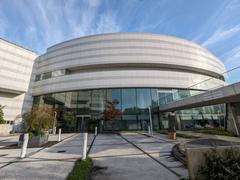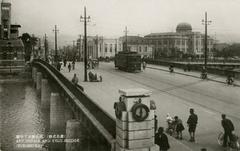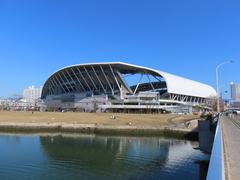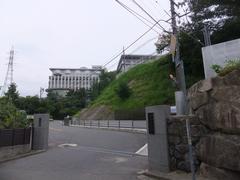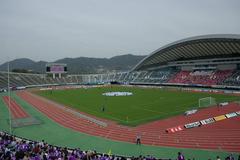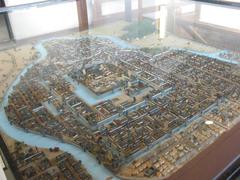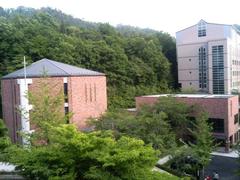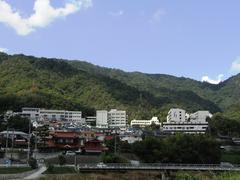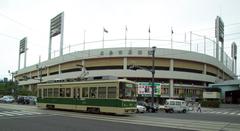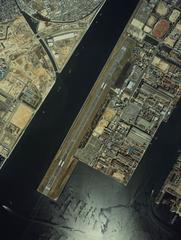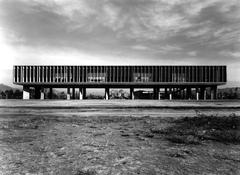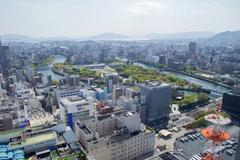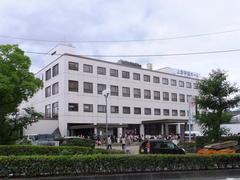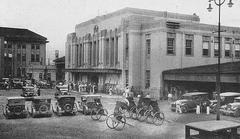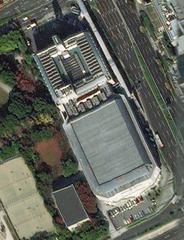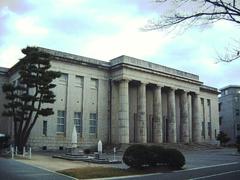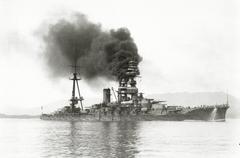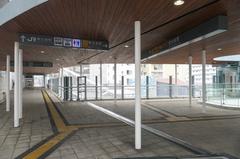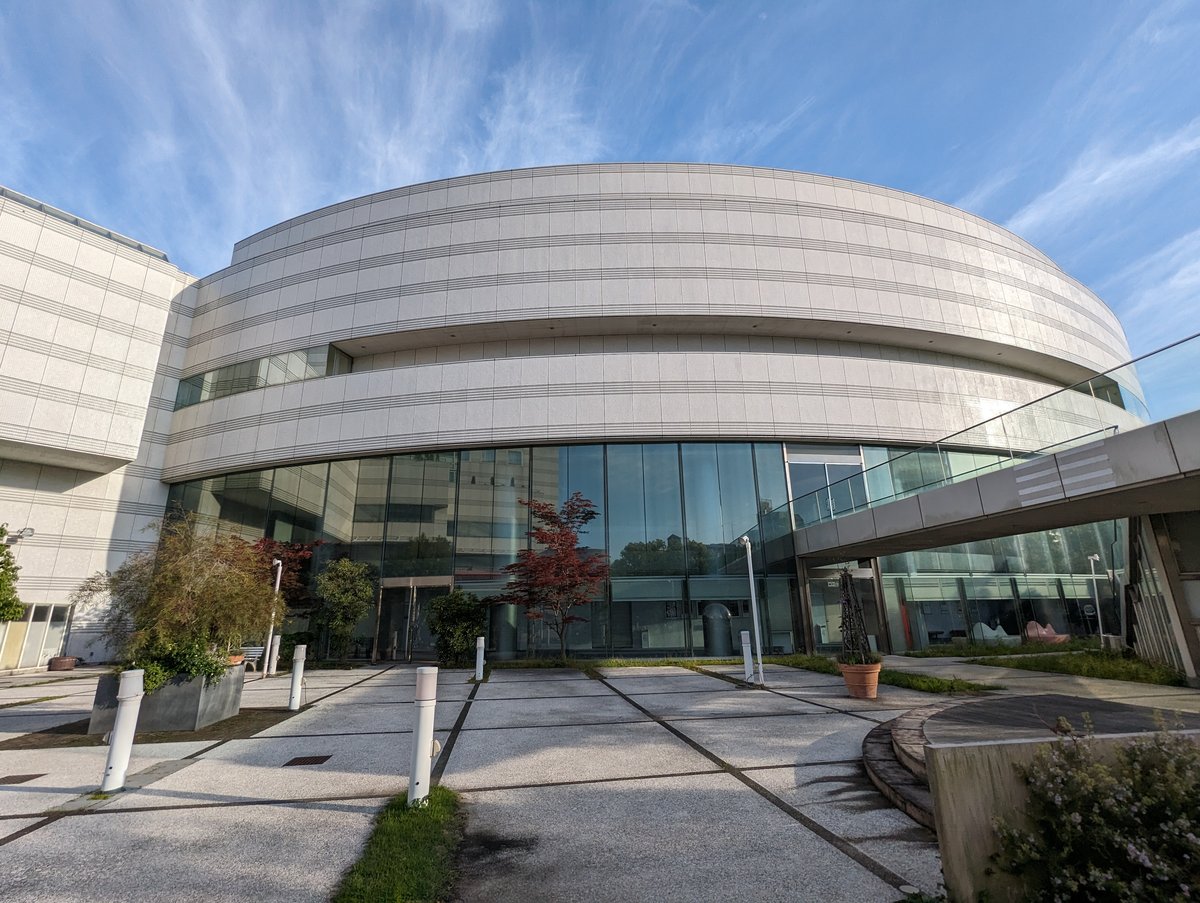
Hiroshima City Cultural Exchange Hall: Visiting Hours, Tickets, and Historical Sites Guide
Date: 15/06/2025
Introduction
The Hiroshima City Cultural Exchange Hall stands as a beacon of Hiroshima’s postwar revival, symbolizing resilience, cultural renewal, and a steadfast commitment to peace. Since its inauguration in 1985, the Hall has served as a versatile venue for international dialogue, community events, and artistic expression—embodying Hiroshima’s evolution from tragedy to a vibrant “City of Peace.” Its strategic location, near landmarks such as Peace Memorial Park and Hiroshima Castle, makes it an essential stop for visitors eager to explore the city’s rich cultural and historical tapestry (Hiroshima City Cultural Exchange Hall Official Website, Japan Travel, MPI Blog).
This comprehensive guide provides all you need to plan your visit—including up-to-date information on visiting hours, ticketing, accessibility, transportation, and nearby attractions. Whether you are a resident or an international traveler, use this resource to enrich your experience of Hiroshima’s cultural heart.
Table of Contents
- Historical Background: Hiroshima’s Journey to Peace
- The Hall’s Purpose and Vision
- Architectural and Cultural Significance
- Visitor Information
- Guided Tours and Events
- Nearby Historical Sites and Suggested Itineraries
- Visitor Tips and Etiquette
- Sustainability and Safety
- Frequently Asked Questions (FAQ)
- Conclusion
- Sources and Further Reading
Historical Background: Hiroshima’s Journey to Peace
Origins and Early Development
Hiroshima’s origins trace back to the establishment of Hiroshima Castle in 1589 by Mōri Terumoto, which catalyzed the city’s growth as a political and cultural center in western Japan. Under subsequent rule by the Asano clan during the Edo period, Hiroshima thrived as a castle town along the Seto Inland Sea, becoming known for its cultural activities and bustling urban life (Tourist in Japan, Japan Travel Note).
The Atomic Bombing and Postwar Reconstruction
The atomic bombing on August 6, 1945, devastated Hiroshima, resulting in the loss of approximately 140,000 lives and obliterating the city’s infrastructure (National Geographic, Academia.edu). The aftermath demanded a complete transformation: Hiroshima, officially declared a “City of Peace” in 1949, committed itself to peace-building, memorialization, and cultural renaissance. This ethos is embodied in institutions such as the Peace Memorial Park and the Hiroshima City Cultural Exchange Hall, both of which serve as platforms for remembrance and international understanding (MPI Blog).
The Hall’s Purpose and Vision
The Hiroshima City Cultural Exchange Hall (広島市文化交流会館) was conceived as a hub for peace, intercultural dialogue, and community engagement. It hosts a diverse array of events—from international concerts and exhibitions to conferences, workshops, and community festivals—bridging local and global audiences. As part of Hiroshima’s broader vision to foster mutual understanding and reconciliation, the Hall plays a pivotal role in supporting lifelong learning and social cohesion (MPI Blog, Dive! Hiroshima).
Architectural and Cultural Significance
The Hall’s modernist architecture reflects a spirit of optimism and inclusivity. Designed for flexibility, its spaces accommodate performances, art exhibitions, and public gatherings. The building’s open layout and accessibility underscore Hiroshima’s commitment to openness and international exchange. Collaborations with local and international artists, as well as proximity to other key cultural institutions, reinforce its status as a cornerstone of the city’s cultural ecosystem (Dive! Hiroshima).
Visitor Information
Visiting Hours
- Monday to Friday: 9:00 AM – 9:00 PM
- Saturday, Sunday, and Public Holidays: 10:00 AM – 8:00 PM
- Closed: December 29 – January 3 (New Year holidays)
Note: Hours may change during special events. Check the official website for current details.
Ticketing
- General Admission: Free for many community events
- Special Events: Ticket prices vary (typically ¥2,000–¥5,000 for concerts and performances)
- Purchase Points: Online, at the Hall’s box office, or through authorized vendors
- Advance Booking: Recommended for popular events
Directions and Access
- Address: 1-5, Nakajima-cho, Naka-ku, Hiroshima City, Hiroshima Prefecture
- By Tram: Hiroden streetcar to Kencho-mae, Hatchobori, or Chuden-mae stations (5–10 min walk)
- By Bus: Multiple city bus lines stop nearby
- From Hiroshima Station: 15–20 minutes by tram or taxi; direct connections via Sanyo Shinkansen for travelers from Osaka, Kyoto, or Fukuoka (Japan Welcomes You, The Invisible Tourist)
- By Car: On-site parking is limited; public transport is recommended
Accessibility
- Barrier-Free Access: Ramps, elevators, accessible restrooms
- Multilingual Services: English-speaking staff and multilingual signage
- Assistive Devices: Available for select events; contact in advance for specific needs
- Support: Cloakrooms, coin lockers, and staff assistance for visitors with disabilities
Facilities and Amenities
- Main Auditorium: Seats up to 2,100; suitable for concerts and conferences
- Multipurpose Rooms: For workshops, seminars, and smaller gatherings
- Café: Light meals, snacks, and beverages (vegetarian options available)
- Gift Shop: Local crafts, books, and Hiroshima-themed souvenirs
- Free Wi-Fi: Available in public areas
- Rest Areas: Family-friendly, with baby-changing facilities
Guided Tours and Events
- Guided Tours: Available by appointment; provide insights into the Hall’s architecture and mission
- Event Calendar: Includes concerts, international conferences, art festivals, and peace symposia (Japan Travel, World History Journal)
- Photographic Spots: Capture the Hall’s unique architectural details and its scenic surroundings, including views toward Peace Memorial Park
Nearby Historical Sites and Suggested Itineraries
The Hall’s location enables visitors to seamlessly experience Hiroshima’s most significant landmarks:
- Peace Memorial Park and Museum: A moving tribute to the city’s atomic bomb victims
- Atomic Bomb Dome: UNESCO World Heritage Site and symbol of resilience
- Hiroshima Castle: Reconstructed castle with historical exhibits
- Shukkeien Garden: Traditional Japanese landscape garden
- Hondori Shopping Arcade and Okonomimura: For local cuisine and shopping (Life of Doing, Dive! Hiroshima)
Suggested Itinerary: Begin at the Cultural Exchange Hall, then walk through Peace Memorial Park, visit the museum, and continue to Hiroshima Castle and Shukkeien Garden for a full day of historical and cultural immersion.
Visitor Tips and Etiquette
- Check Event Schedules: Consult the Hall’s website for up-to-date event listings and ticketing information
- Arrive Early: For popular events, arrive at least 30 minutes in advance
- Use Public Transport: Hiroshima’s trams and buses are efficient; consider using an IC card (Suica or Icoca) (Live Japan)
- Weather Prep: June–July is rainy season—bring an umbrella or raincoat
- Customs: Be punctual, speak quietly, and silence phones during events
- Photography: Always check event-specific policies before taking photos
- Language Support: Translation apps or phrasebooks may be helpful for complex requests
- Accessibility: Contact the Hall ahead for special accommodations
Sustainability and Safety
- Eco-Friendly Initiatives: Energy-efficient lighting, recycling, and locally sourced café offerings (World History Journal)
- Safety: Security staff present during major events; emergency exits are clearly marked
- Non-Smoking: Smoking permitted only in designated outdoor areas
Frequently Asked Questions (FAQ)
Q: What are the Hiroshima City Cultural Exchange Hall’s visiting hours?
A: Usually 9:00 AM–9:00 PM on weekdays, 10:00 AM–8:00 PM weekends/holidays. Check the official website for updates.
Q: Is there an entrance fee?
A: Most community events are free; ticketed events have varying prices.
Q: Are guided tours available?
A: Yes, by appointment or during certain events. See the Hall’s event calendar.
Q: Is the Hall wheelchair accessible?
A: Yes, with ramps, elevators, and accessible restrooms.
Q: How do I get there by public transport?
A: Use the Hiroden streetcar to Kencho-mae, Hatchobori, or Chuden-mae; walk 5–10 minutes.
Q: What nearby sites can I visit?
A: Peace Memorial Park, Atomic Bomb Dome, Hiroshima Castle, Shukkeien Garden—all within walking distance.
Conclusion
The Hiroshima City Cultural Exchange Hall is a dynamic center for cultural exchange, artistic innovation, and peace-building. Its accessible facilities, diverse programming, and prime location make it an essential destination for anyone exploring Hiroshima’s unique blend of history and contemporary culture. By planning ahead—reviewing event schedules, securing tickets, and exploring nearby landmarks—you can experience the best of what Hiroshima has to offer.
For the latest news, event updates, and travel tips, visit the official Hall website, download the Audiala app, and follow our social channels. Let your journey to Hiroshima’s cultural heart be informed, inspiring, and unforgettable.
Sources and Further Reading
- Tourist in Japan
- Japan Travel Note
- National Geographic
- Academia.edu
- MPI Blog
- Dive! Hiroshima
- Explore Hiroshima
- Japan Travel
- World History Journal
- Japan Welcomes You
- The Invisible Tourist
- Dive Hiroshima
- Japan Travel - Events
- Live Japan
- Life of Doing
